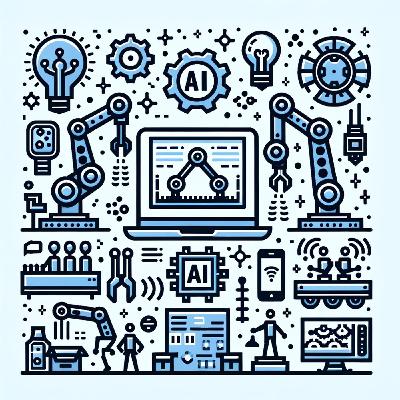Cobots Invade Factories: AI-Powered Bots Steal Jobs and Hearts
Update: 2025-11-26
Description
This is you Industrial Robotics Weekly: Manufacturing & AI Updates podcast.
Industrial robotics continue to drive the transformation of manufacturing as the sector embraces a convergence of automation, advanced sensor networks, and artificial intelligence. Across factory floors, the rise of cobots—collaborative robots—and mobile manipulators is enabling dynamic, safe, and flexible team environments between humans and machines. According to the International Federation of Robotics, the global market for industrial robot installations reached an all-time high of sixteen and a half billion US dollars this year, with notable expansion in warehouse and logistics automation, alongside core industrial applications. Listeners can see real examples in North American automotive plants, where AI-equipped cobots now assemble vehicle interiors and perform real-time product quality checks, cutting rework rates by nearly fifteen percent over last year.
Industry data from Deloitte’s 2025 Smart Manufacturing Survey reinforces why ninety-two percent of leading manufacturers rank smart technologies and robotics as their top priority for productivity growth and resilience. The strategic focus is on core investments like sensors, data analytics, and cloud platforms, with forty one percent of executives boosting spending on automation hardware and nearly a third prioritizing integrated vision and quality systems. One trend to watch is modular and customizable robotic platforms, as reported by Robotnik, which allow manufacturers to rapidly adapt production lines for new products or changing market requirements—delivering a measurable advantage in agility and cost control.
In real warehouses and assembly plants, digital twins—virtual replicas powered by live production data—are now mainstream tools. Companies use them to simulate, optimize, and monitor complex operations, reducing downtime and accelerating the launch of new processes. Meanwhile, manufacturers cite worker safety and ergonomic gains: cobots and mobile robots handle hazardous or repetitive tasks, while human operators focus on oversight, troubleshooting, and process innovation.
From a financial perspective, ArcherPoint reports that factories leveraging AI and robotics see up to thirty percent jumps in output per hour and savings on maintenance and resource use, resulting in faster return on automation investments. However, transitioning to a highly automated facility requires not only capital outlays but also strategic workforce upskilling and adoption of industry-wide standards, such as unified data models and secure connectivity protocols.
Looking ahead, manufacturers should prioritize deploying sensor-rich robots, invest in robust training, and explore scalable cloud robotics solutions. Expect rapid progress in AI-powered predictive analytics, sustainable energy management, and green robotics practices, supporting both operational efficiency and environmental targets.
Thank you for tuning in to Industrial Robotics Weekly. Be sure to join us again next week for fresh insights and news. This has been a Quiet Please production—and for more, check out Quiet Please Dot A I.
For more http://www.quietplease.ai
Get the best deals https://amzn.to/3ODvOta
This content was created in partnership and with the help of Artificial Intelligence AI
Industrial robotics continue to drive the transformation of manufacturing as the sector embraces a convergence of automation, advanced sensor networks, and artificial intelligence. Across factory floors, the rise of cobots—collaborative robots—and mobile manipulators is enabling dynamic, safe, and flexible team environments between humans and machines. According to the International Federation of Robotics, the global market for industrial robot installations reached an all-time high of sixteen and a half billion US dollars this year, with notable expansion in warehouse and logistics automation, alongside core industrial applications. Listeners can see real examples in North American automotive plants, where AI-equipped cobots now assemble vehicle interiors and perform real-time product quality checks, cutting rework rates by nearly fifteen percent over last year.
Industry data from Deloitte’s 2025 Smart Manufacturing Survey reinforces why ninety-two percent of leading manufacturers rank smart technologies and robotics as their top priority for productivity growth and resilience. The strategic focus is on core investments like sensors, data analytics, and cloud platforms, with forty one percent of executives boosting spending on automation hardware and nearly a third prioritizing integrated vision and quality systems. One trend to watch is modular and customizable robotic platforms, as reported by Robotnik, which allow manufacturers to rapidly adapt production lines for new products or changing market requirements—delivering a measurable advantage in agility and cost control.
In real warehouses and assembly plants, digital twins—virtual replicas powered by live production data—are now mainstream tools. Companies use them to simulate, optimize, and monitor complex operations, reducing downtime and accelerating the launch of new processes. Meanwhile, manufacturers cite worker safety and ergonomic gains: cobots and mobile robots handle hazardous or repetitive tasks, while human operators focus on oversight, troubleshooting, and process innovation.
From a financial perspective, ArcherPoint reports that factories leveraging AI and robotics see up to thirty percent jumps in output per hour and savings on maintenance and resource use, resulting in faster return on automation investments. However, transitioning to a highly automated facility requires not only capital outlays but also strategic workforce upskilling and adoption of industry-wide standards, such as unified data models and secure connectivity protocols.
Looking ahead, manufacturers should prioritize deploying sensor-rich robots, invest in robust training, and explore scalable cloud robotics solutions. Expect rapid progress in AI-powered predictive analytics, sustainable energy management, and green robotics practices, supporting both operational efficiency and environmental targets.
Thank you for tuning in to Industrial Robotics Weekly. Be sure to join us again next week for fresh insights and news. This has been a Quiet Please production—and for more, check out Quiet Please Dot A I.
For more http://www.quietplease.ai
Get the best deals https://amzn.to/3ODvOta
This content was created in partnership and with the help of Artificial Intelligence AI
Comments
In Channel





